engine coolant HYUNDAI SONATA HYBRID 2022 Owner's Manual
[x] Cancel search | Manufacturer: HYUNDAI, Model Year: 2022, Model line: SONATA HYBRID, Model: HYUNDAI SONATA HYBRID 2022Pages: 527, PDF Size: 64.14 MB
Page 466 of 527
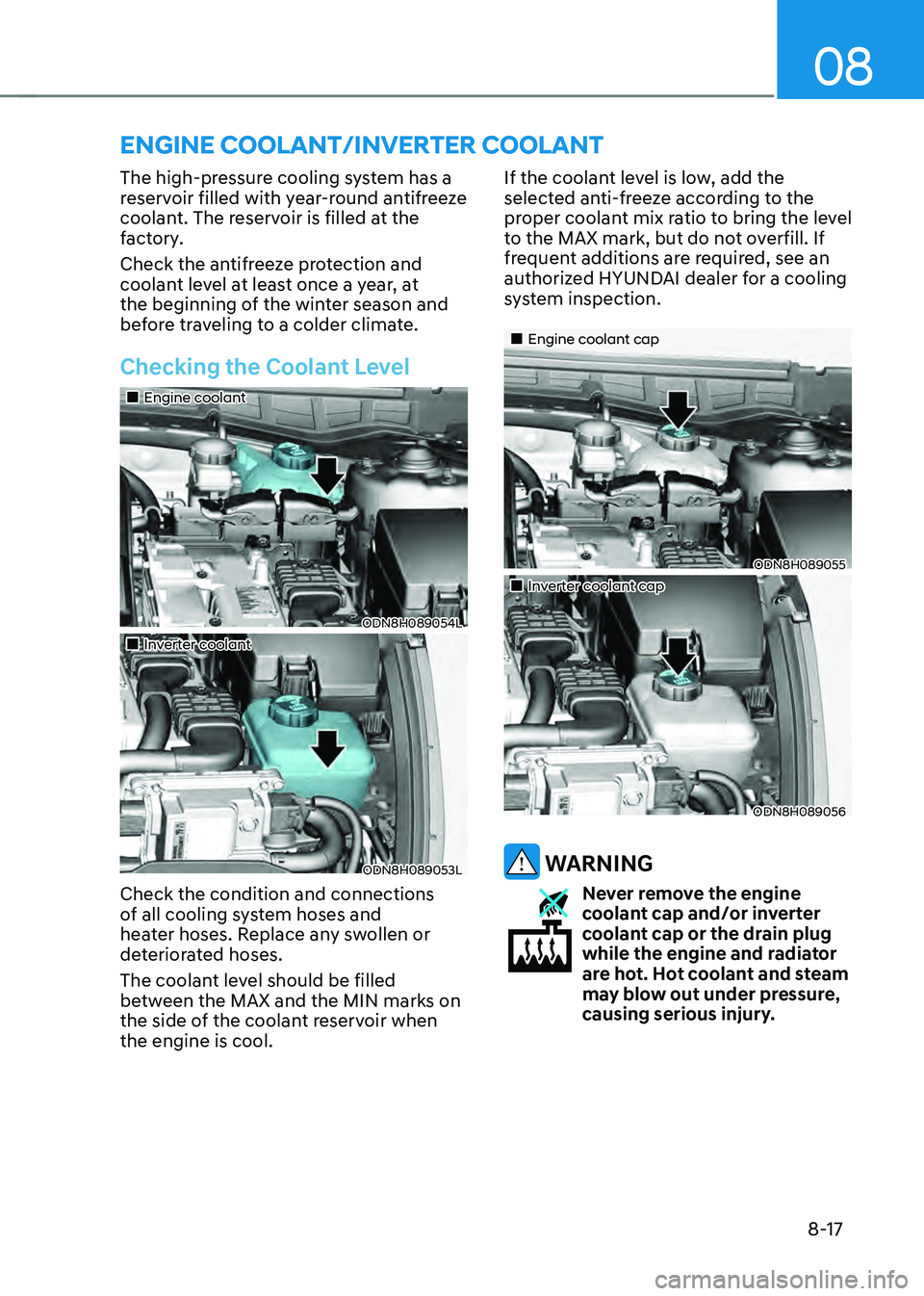
08
8-17
The high-pressure cooling system has a
reservoir filled with year-round antifreeze
coolant. The reservoir is filled at the
factory.
Check the antifreeze protection and
coolant level at least once a year, at
the beginning of the winter season and
before traveling to a colder climate.
Checking the Coolant Level
„„Engine coolant
ODN8H089054L
„„Inverter coolant
ODN8H089053L
Check the condition and connections
of all cooling system hoses and
heater hoses. Replace any swollen or
deteriorated hoses.
The coolant level should be filled
between the MAX and the MIN marks on
the side of the coolant reservoir when
the engine is cool.If the coolant level is low, add the
selected anti-freeze according to the proper coolant mix ratio to bring the level to the MAX mark, but do not overfill. If
frequent additions are required, see an
authorized HYUNDAI dealer for a cooling
system inspection.
„„Engine coolant cap
ODN8H089055
„„Inverter coolant cap
ODN8H089056
WARNING
Never remove the engine coolant cap and/or inverter
coolant cap or the drain plug
while the engine and radiator
are hot. Hot coolant and steam
may blow out under pressure,
causing serious injury.
ENGINE COOLANT/INVERTER COOLANT
Page 467 of 527
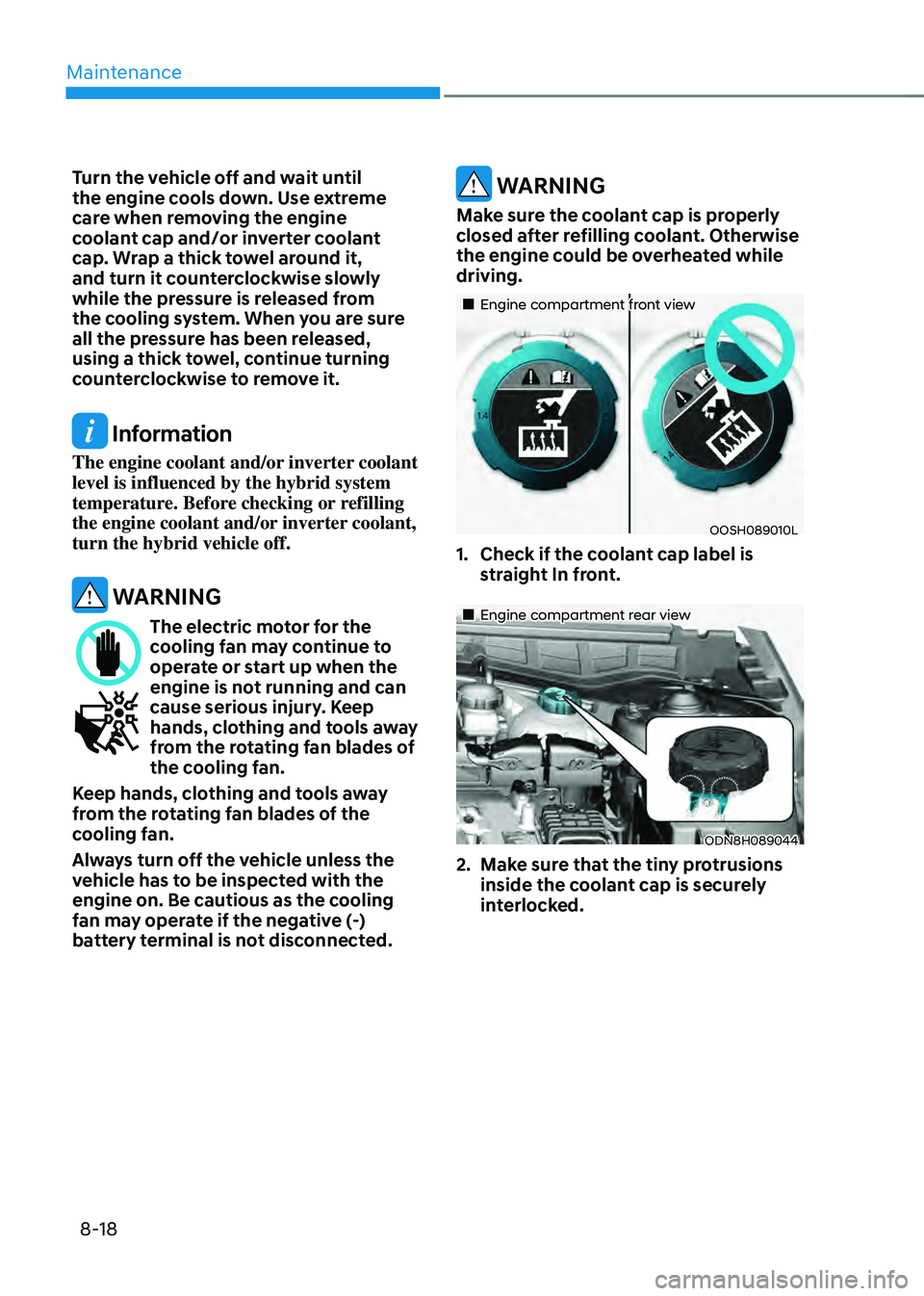
Maintenance
8-18
Turn the vehicle off and wait until
the engine cools down. Use extreme
care when removing the engine
coolant cap and/or inverter coolant
cap. Wrap a thick towel around it,
and turn it counterclockwise slowly
while the pressure is released from
the cooling system. When you are sure
all the pressure has been released,
using a thick towel, continue turning
counterclockwise to remove it.
Information
The engine coolant and/or inverter coolant
level is influenced by the hybrid system
temperature. Before checking or refilling
the engine coolant and/or inverter coolant,
turn the hybrid vehicle off.
WARNING
The electric motor for the cooling fan may continue to
operate or start up when the
engine is not running and can
cause serious injury. Keep
hands, clothing and tools away
from the rotating fan blades of
the cooling fan.
Keep hands, clothing and tools away
from the rotating fan blades of the
cooling fan.
Always turn off the vehicle unless the
vehicle has to be inspected with the
engine on. Be cautious as the cooling
fan may operate if the negative (-)
battery terminal is not disconnected.
WARNING
Make sure the coolant cap is properly
closed after refilling coolant. Otherwise
the engine could be overheated while
driving.
„„Engine compartment front view
OOSH089010L
1. Check if the coolant cap label is
straight In front.
„„Engine compartment rear view
ODN8H089044
2. Make sure that the tiny protrusions
inside the coolant cap is securely
interlocked.
Page 468 of 527
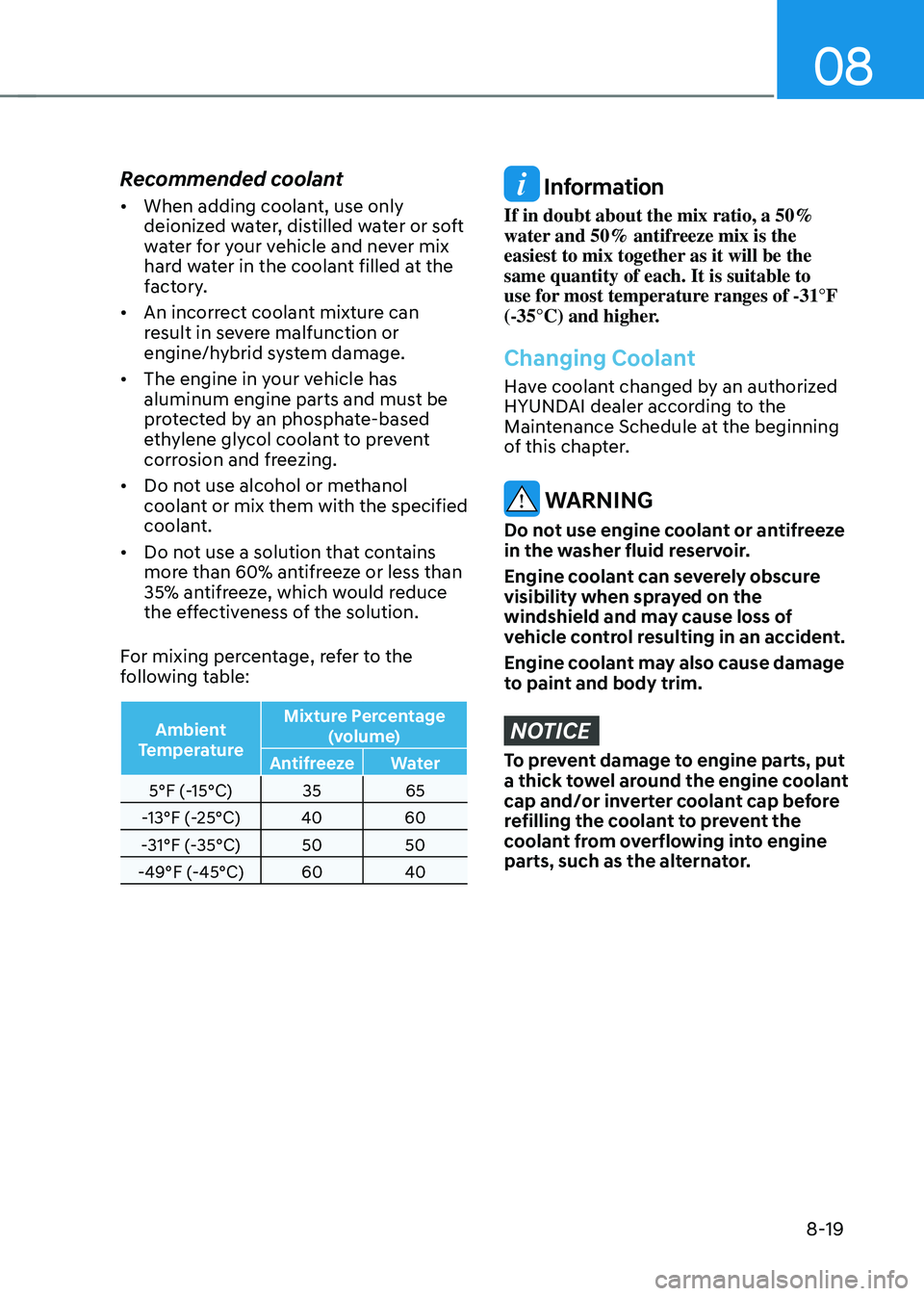
08
8-19
Recommended coolant
• When adding coolant, use only
deionized water, distilled water or soft
water for your vehicle and never mix
hard water in the coolant filled at the
factory.
• An incorrect coolant mixture can
result in severe malfunction or
engine/hybrid system damage.
• The engine in your vehicle has
aluminum engine parts and must be
protected by an phosphate-based
ethylene glycol coolant to prevent
corrosion and freezing.
• Do not use alcohol or methanol
coolant or mix them with the specified
coolant.
• Do not use a solution that contains
more than 60% antifreeze or less than
35% antifreeze, which would reduce
the effectiveness of the solution.
For mixing percentage, refer to the
following table:
Ambient
Temperature Mixture Percentage
(volume)
Antifreeze Water
5°F (-15°C) 3565
-13°F (-25°C) 4060
-31°F (-35°C) 5050
-49°F (-45°C) 6040
Information
If in doubt about the mix ratio, a 50%
water and 50% antifreeze mix is the
easiest to mix together as it will be the
same quantity of each. It is suitable to
use for most temperature ranges of -31°F
(-35°C) and higher.
Changing Coolant
Have coolant changed by an authorized
HYUNDAI dealer according to the
Maintenance Schedule at the beginning
of this chapter.
WARNING
Do not use engine coolant or antifreeze
in the washer fluid reservoir.
Engine coolant can severely obscure
visibility when sprayed on the
windshield and may cause loss of
vehicle control resulting in an accident.
Engine coolant may also cause damage
to paint and body trim.
NOTICE
To prevent damage to engine parts, put
a thick towel around the engine coolant
cap and/or inverter coolant cap before
refilling the coolant to prevent the
coolant from overflowing into engine
parts, such as the alternator.
Page 470 of 527
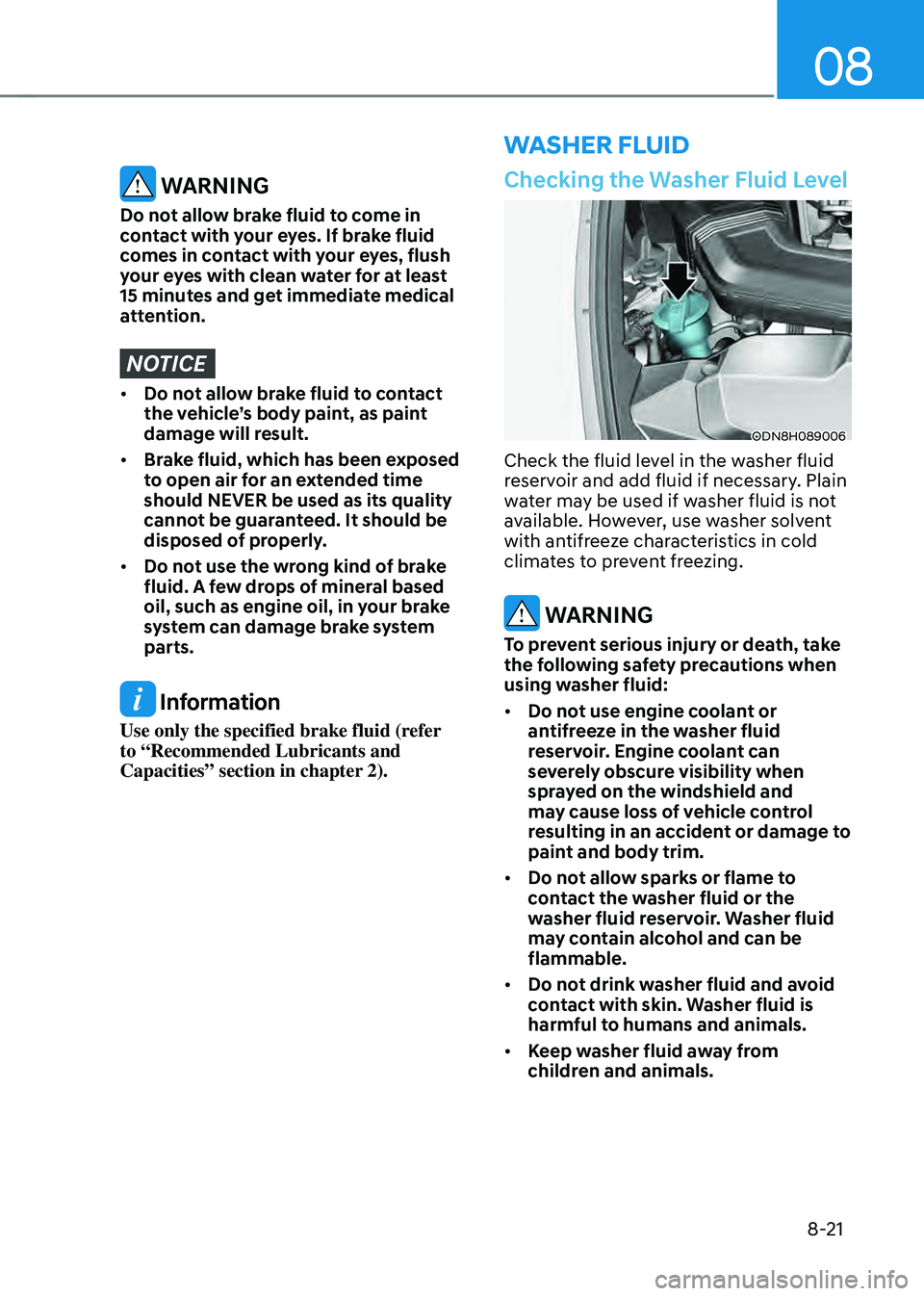
08
8-21
WASHER FLUID
Checking the Washer Fluid Level
ODN8H089006
Check the fluid level in the washer fluid
reservoir and add fluid if necessary. Plain
water may be used if washer fluid is not
available. However, use washer solvent
with antifreeze characteristics in cold
climates to prevent freezing.
WARNING
To prevent serious injury or death, take
the following safety precautions when
using washer fluid:
• Do not use engine coolant or
antifreeze in the washer fluid
reservoir. Engine coolant can
severely obscure visibility when
sprayed on the windshield and
may cause loss of vehicle control
resulting in an accident or damage to
paint and body trim.
• Do not allow sparks or flame to
contact the washer fluid or the
washer fluid reservoir. Washer fluid
may contain alcohol and can be
flammable.
• Do not drink washer fluid and avoid
contact with skin. Washer fluid is
harmful to humans and animals.
• Keep washer fluid away from
children and animals.
WARNING
Do not allow brake fluid to come in
contact with your eyes. If brake fluid
comes in contact with your eyes, flush
your eyes with clean water for at least
15 minutes and get immediate medical
attention.
NOTICE
• Do not allow brake fluid to contact
the vehicle’s body paint, as paint
damage will result.
• Brake fluid, which has been exposed
to open air for an extended time
should NEVER be used as its quality
cannot be guaranteed. It should be
disposed of properly.
• Do not use the wrong kind of brake
fluid. A few drops of mineral based
oil, such as engine oil, in your brake
system can damage brake system
parts.
Information
Use only the specified brake fluid (refer
to “Recommended Lubricants and
Capacities” section in chapter 2).
Page 506 of 527
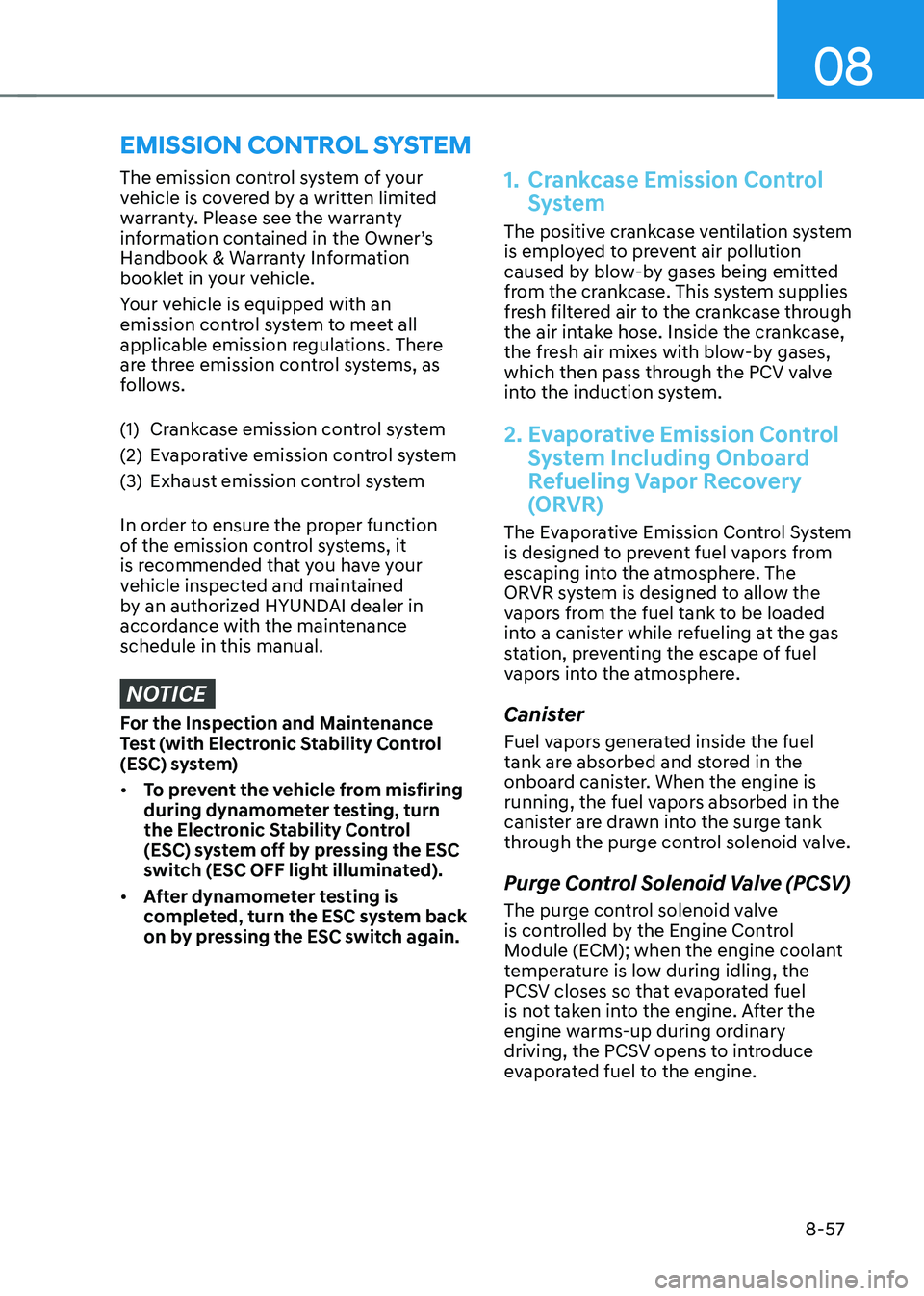
08
8-57
The emission control system of your
vehicle is covered by a written limited
warranty. Please see the warranty
information contained in the Owner’s
Handbook & Warranty Information
booklet in your vehicle.
Your vehicle is equipped with an
emission control system to meet all
applicable emission regulations. There
are three emission control systems, as
follows.
(1) Crankcase emission control system
(2) Evaporative emission control system
(3) Exhaust emission control system
In order to ensure the proper function
of the emission control systems, it
is recommended that you have your
vehicle inspected and maintained
by an authorized HYUNDAI dealer in
accordance with the maintenance
schedule in this manual.
NOTICE
For the Inspection and Maintenance
Test (with Electronic Stability Control
(ESC) system)
• To prevent the vehicle from misfiring
during dynamometer testing, turn
the Electronic Stability Control
(ESC) system off by pressing the ESC
switch (ESC OFF light illuminated).
• After dynamometer testing is
completed, turn the ESC system back
on by pressing the ESC switch again.
1. Crankcase Emission Control
System
The positive crankcase ventilation system
is employed to prevent air pollution
caused by blow-by gases being emitted
from the crankcase. This system supplies
fresh filtered air to the crankcase through
the air intake hose. Inside the crankcase,
the fresh air mixes with blow-by gases,
which then pass through the PCV valve
into the induction system.
2. Evaporative Emission Control
System Including Onboard
Refueling Vapor Recovery
(ORVR)
The Evaporative Emission Control System
is designed to prevent fuel vapors from
escaping into the atmosphere. The
ORVR system is designed to allow the
vapors from the fuel tank to be loaded
into a canister while refueling at the gas
station, preventing the escape of fuel
vapors into the atmosphere.
Canister
Fuel vapors generated inside the fuel
tank are absorbed and stored in the
onboard canister. When the engine is
running, the fuel vapors absorbed in the
canister are drawn into the surge tank
through the purge control solenoid valve.
Purge Control Solenoid Valve (PCSV)
The purge control solenoid valve
is controlled by the Engine Control
Module (ECM); when the engine coolant
temperature is low during idling, the
PCSV closes so that evaporated fuel
is not taken into the engine. After the
engine warms-up during ordinary
driving, the PCSV opens to introduce
evaporated fuel to the engine.
EMISSION CONTROL SYSTEM
Page 514 of 527
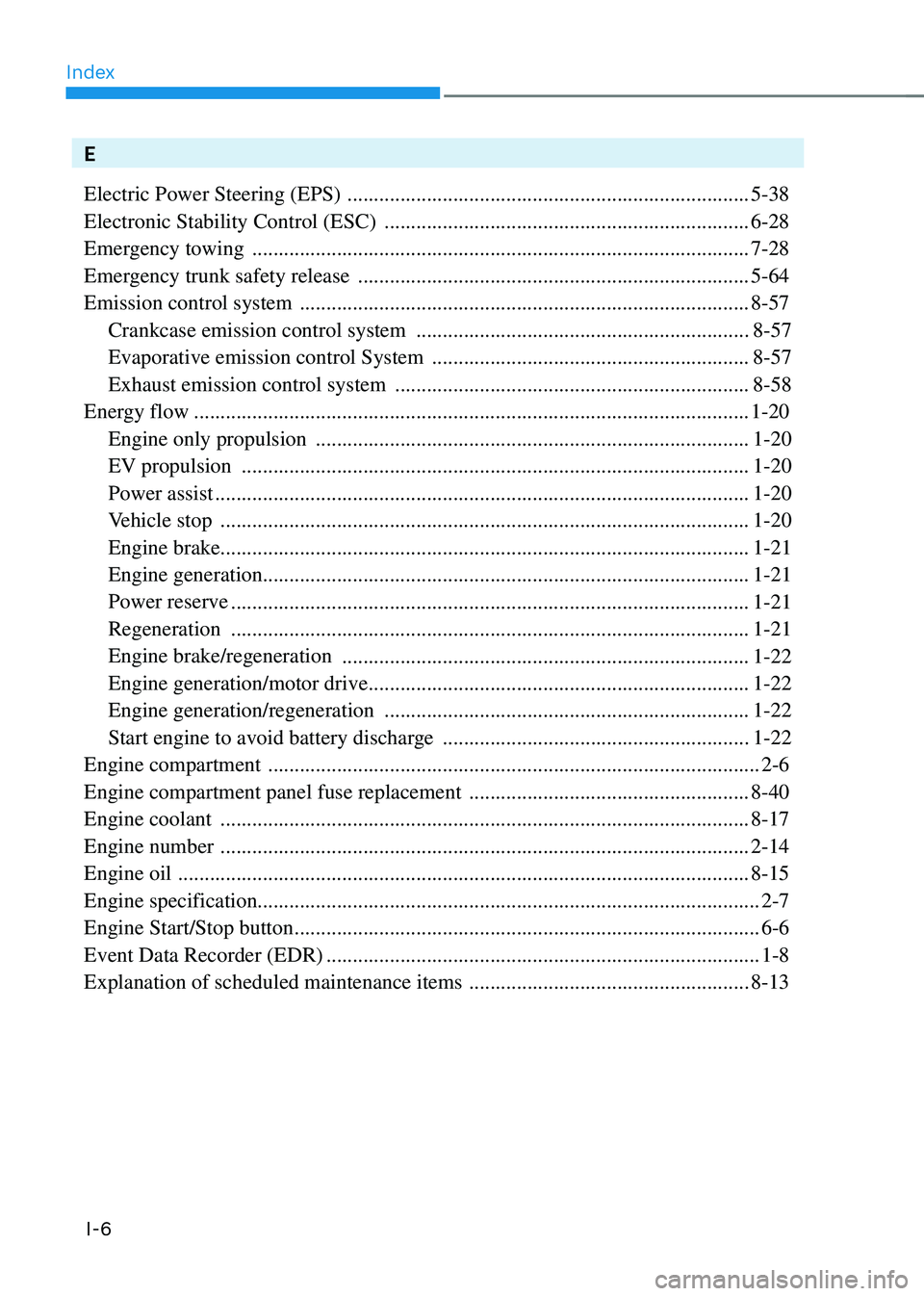
Index
I-6
E
Electric Power Steering (EPS)
........................................................................\
....5-38
Electronic Stability Control (ESC)
.....................................................................6-28
Emergency towing
........................................................................\
......................7-28
Emergency trunk safety release
........................................................................\
..5-64
Emission control system
........................................................................\
.............8-57
Crankcase emission control system
...............................................................8-57
Evaporative emission control System
............................................................8-57
Exhaust emission control system
...................................................................8-58
Energy flow
........................................................................\
.................................1-20
Engine only propulsion
........................................................................\
..........1-20
EV propulsion
........................................................................\
........................1-20
Power assist
........................................................................\
.............................1-20
Vehicle stop
........................................................................\
............................1-20
Engine brake ........................................................................\
............................ 1-21
Engine generation ........................................................................\
.................... 1-21
Power reserve
........................................................................\
..........................1-21
Regeneration
........................................................................\
..........................1-21
Engine brake/regeneration
........................................................................\
.....1-22
Engine generation/motor drive
........................................................................\
1-22
Engine generation/regeneration
.....................................................................1-22
Start engine to avoid battery discharge
..........................................................1-22
Engine compartment
........................................................................\
.....................2-6
Engine compartment panel fuse replacement
.....................................................8-40
Engine coolant
........................................................................\
............................8-17
Engine number
........................................................................\
............................2-14
Engine oil
........................................................................\
....................................8-15
Engine specification ........................................................................\
....................... 2-7
Engine Start/Stop button
........................................................................\
................6-6
Event Data Recorder (EDR)
........................................................................\
..........1-8
Explanation of scheduled maintenance items
.....................................................8-13
Page 520 of 527
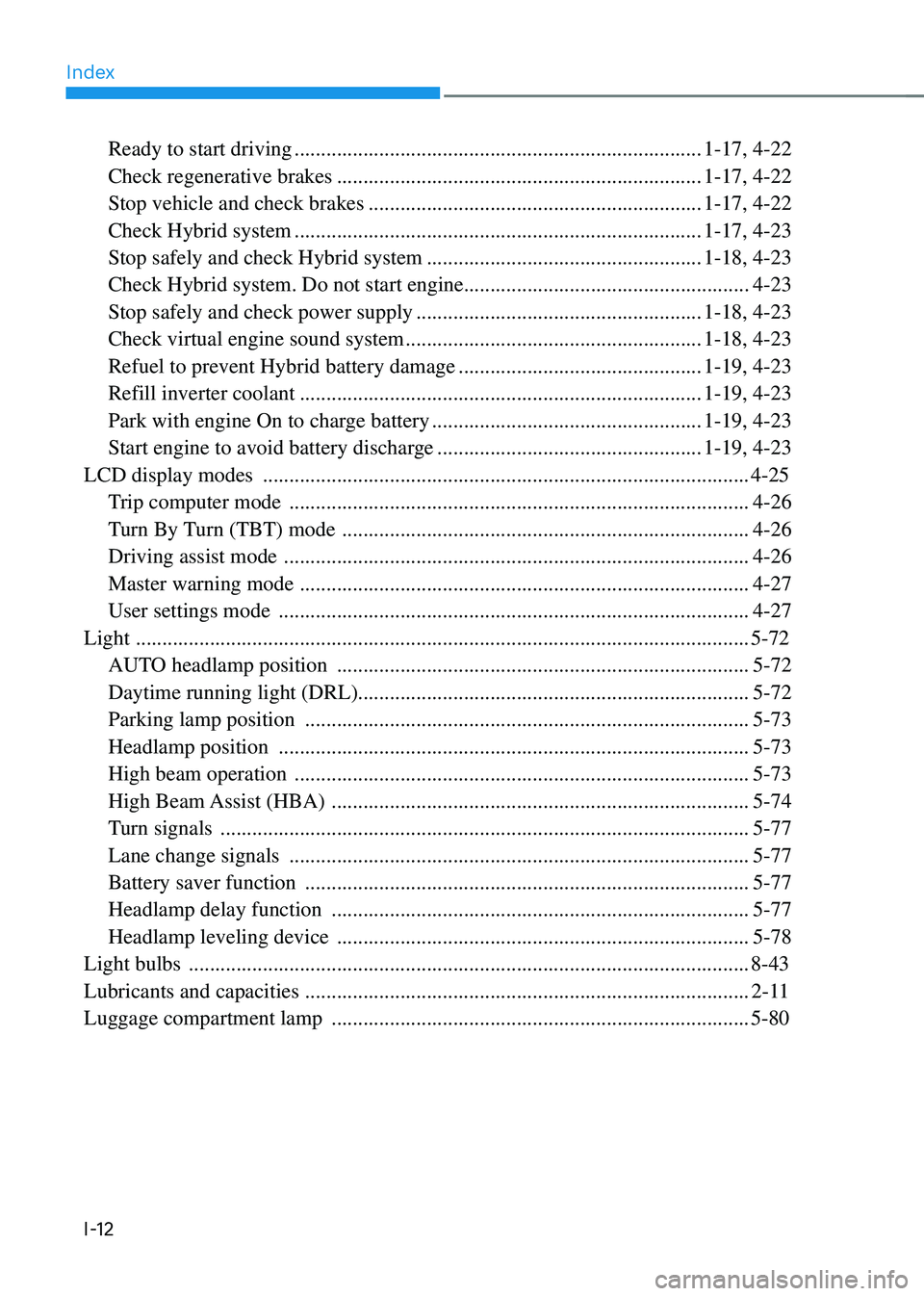
Index
I-12
Ready to start driving ........................................................................\
.....1-17, 4-22
Check regenerative brakes
.....................................................................1-17, 4-22
Stop vehicle and check brakes
...............................................................1-17, 4-22
Check Hybrid system
........................................................................\
.....1-17, 4-23
Stop safely and check Hybrid system
....................................................1-18, 4-23
Check Hybrid system. Do not start engine ......................................................4-23
Stop safely and check power supply
......................................................1-18, 4-23
Check virtual engine sound system
........................................................1-18, 4-23
Refuel to prevent Hybrid battery damage
..............................................1-19, 4-23
Refill inverter coolant
........................................................................\
....1-19, 4-23
Park with engine On to charge battery
...................................................1-19, 4-23
Start engine to avoid battery discharge
..................................................1-19, 4-23
LCD display modes
........................................................................\
....................4-25
Trip computer mode
........................................................................\
...............4-26
Turn By Turn (TBT) mode
........................................................................\
.....4-26
Driving assist mode
........................................................................\
................4-26
Master warning mode
........................................................................\
.............4-27
User settings mode
........................................................................\
.................4-27
Light
........................................................................\
............................................5-72
AUTO headlamp position
........................................................................\
......5-72
Daytime running light (DRL) ........................................................................\
.. 5-72
Parking lamp position
........................................................................\
............5-73
Headlamp position
........................................................................\
.................5-73
High beam operation
........................................................................\
..............5-73
High Beam Assist (HBA)
........................................................................\
.......5-74
Turn signals
........................................................................\
............................5-77
Lane change signals
........................................................................\
...............5-77
Battery saver function
........................................................................\
............5-77
Headlamp delay function
........................................................................\
.......5-77
Headlamp leveling device
........................................................................\
......5-78
Light bulbs
........................................................................\
..................................8-43
Lubricants and capacities
........................................................................\
............2-11
Luggage compartment lamp
........................................................................\
.......5-80
Page 525 of 527
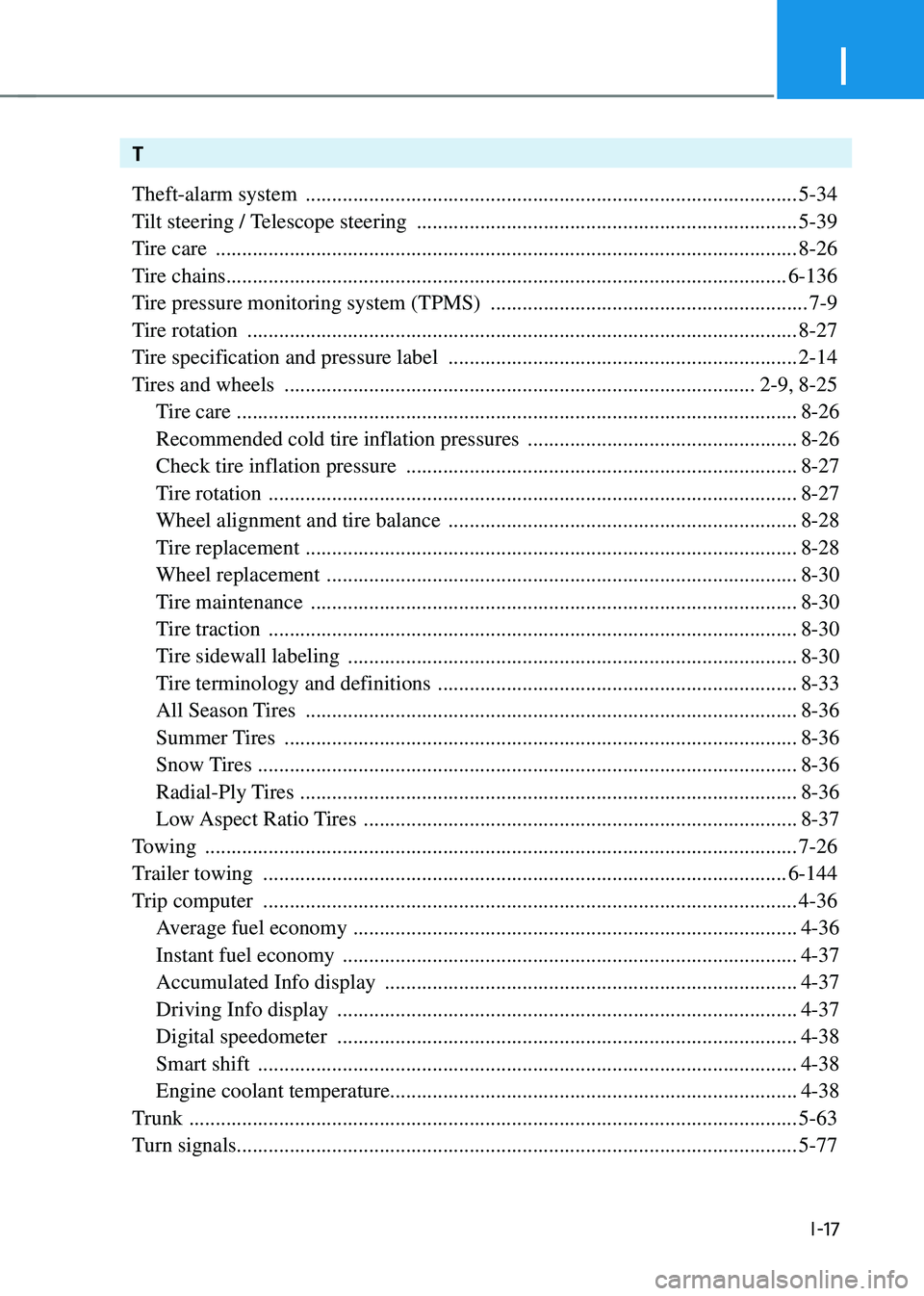
I
I-17
T
Theft-alarm system
........................................................................\
.....................5-34
Tilt steering / Telescope steering
........................................................................\
5-39
Tire care
........................................................................\
......................................8-26
Tire chains ........................................................................\
.................................. 6-136
Tire pressure monitoring system (TPMS)
............................................................7-9
Tire rotation
........................................................................\
................................8-27
Tire specification and pressure label
..................................................................2-14
Tires and wheels
........................................................................\
.................2-9, 8-25
Tire care
........................................................................\
..................................8-26
Recommended cold tire inflation pressures
...................................................8-26
Check tire inflation pressure
........................................................................\
..8-27
Tire rotation
........................................................................\
............................8-27
Wheel alignment and tire balance
..................................................................8-28
Tire replacement
........................................................................\
.....................8-28
Wheel replacement
........................................................................\
.................8-30
Tire maintenance
........................................................................\
....................8-30
Tire traction
........................................................................\
............................8-30
Tire sidewall labeling
........................................................................\
.............8-30
Tire terminology and definitions
....................................................................8-33
All Season Tires
........................................................................\
.....................8-36
Summer Tires
........................................................................\
.........................8-36
Snow Tires
........................................................................\
..............................8-36
Radial-Ply Tires
........................................................................\
......................8-36
Low Aspect Ratio Tires
........................................................................\
..........8-37
Towing
........................................................................\
........................................7-26
Trailer towing
........................................................................\
...........................6-144
Trip computer
........................................................................\
.............................4-36
Average fuel economy
........................................................................\
............4-36
Instant fuel economy
........................................................................\
..............4-37
Accumulated Info display
........................................................................\
......4-37
Driving Info display
........................................................................\
...............4-37
Digital speedometer
........................................................................\
...............4-38
Smart shift
........................................................................\
..............................4-38
Engine coolant temperature ........................................................................\
..... 4-38
Trunk
........................................................................\
...........................................5-63
Turn signals ........................................................................\
.................................. 5-77